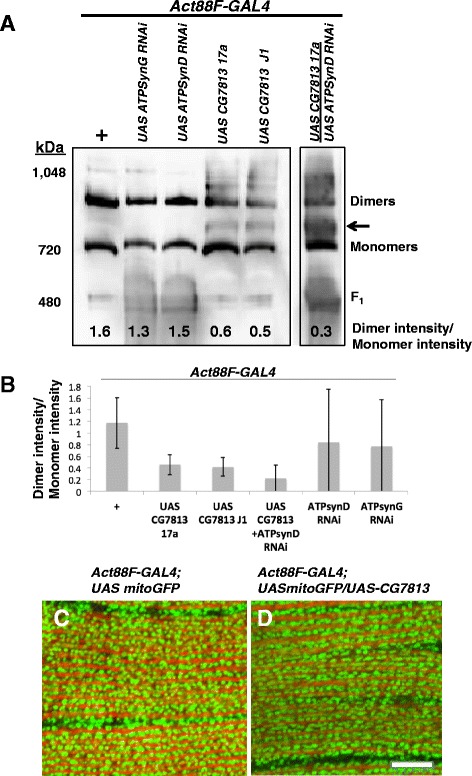Fig. 4.

Knon expression in flight muscle alters ATP synthase dimer:monomer ratio but not gross mitochondrial morphology. a Immunoblot using anti-ATP synthase α subunit antibodies on a BN-PAGE gel of mitochondrial isolates from flight muscle of the indicated genotypes. The Act88F-GAL4 flight muscle driver was used as a control (first lane), as well as to drive exogenous Knon (CG7813) expression from two independent transgene insertions (fourth and fifth lanes), RNAi knockdown constructs of ATP synthase subunits g (second lane) and d (third lane), or simultaneous exogenous CG7813 expression and knockdown of ATP synthase subunit d (sixth lane). Dimer/monomer intensity ratios are indicated at bottom. Expressing Knon (CG7813), either with or without concurrent knockdown of the broadly-expressed ATPsynD, reduced the amount of ATP synthase dimers relative to monomers and gave rise to detectable bands of slightly larger size (arrow) than the typical monomer bands. b Quantification of dimer/monomer band intensity ratios from multiple biological replicates (n = 3 for +, UAS CG7813 17a, and UAS CG7813 J1; n = 4 for UAS CG7813 + ATPsynD RNAi; n = 2 for ATPsynD RNAi and ATPsynG RNAi). Error bars represent 95% confidence intervals. c-d Confocal images of Drosophila flight muscle from Act88F-GAL4; UAS-mitoGFP (c) flies and Act88F-GAL4; UAS-mitoGFP/UAS-CG7813 flies (d). Scale bar 10 μm
